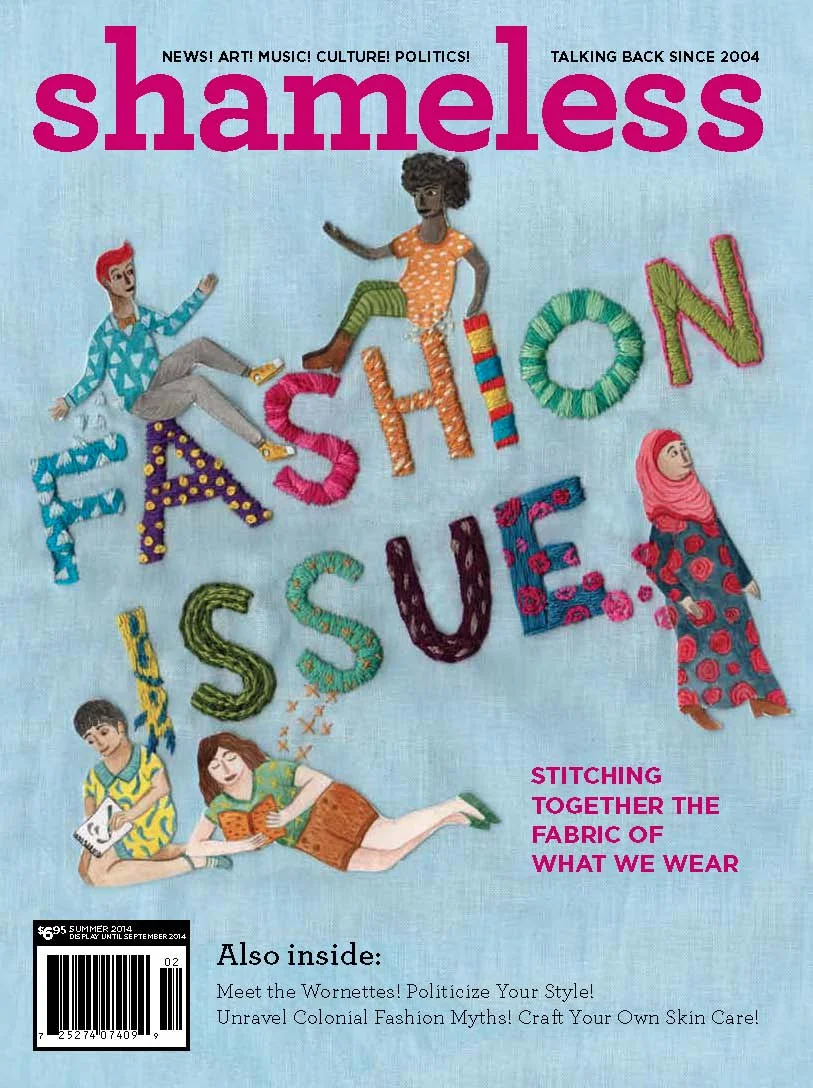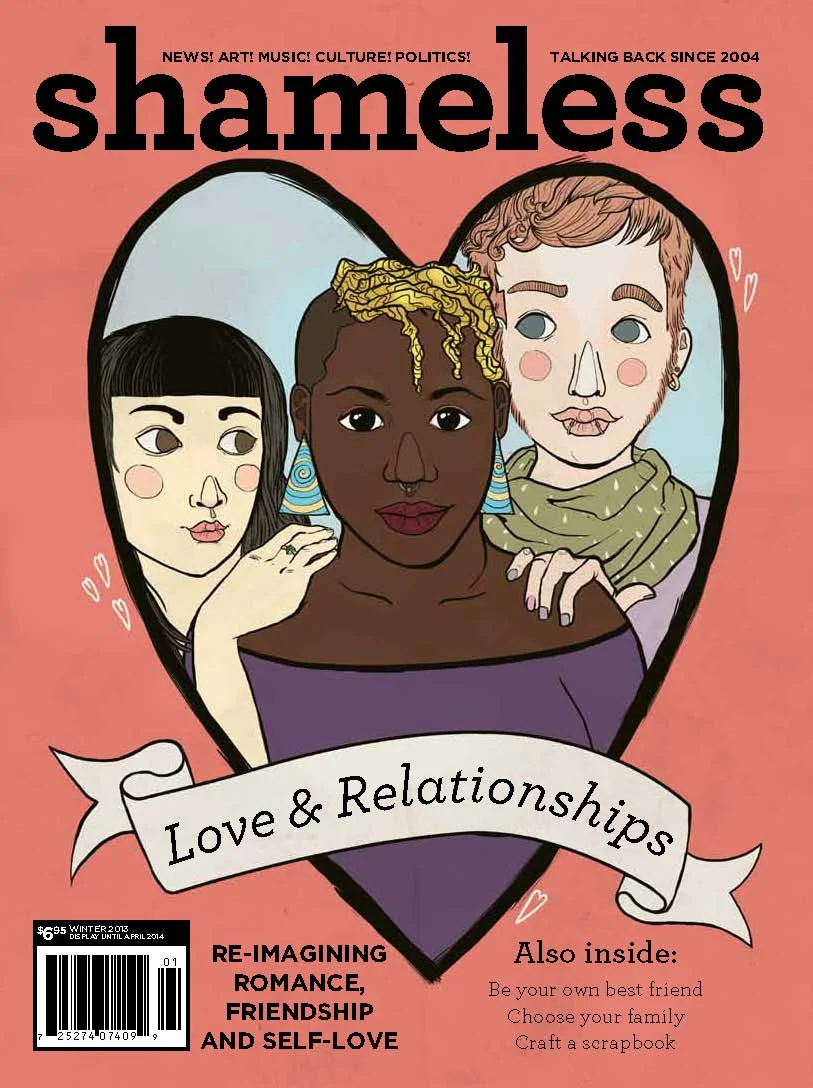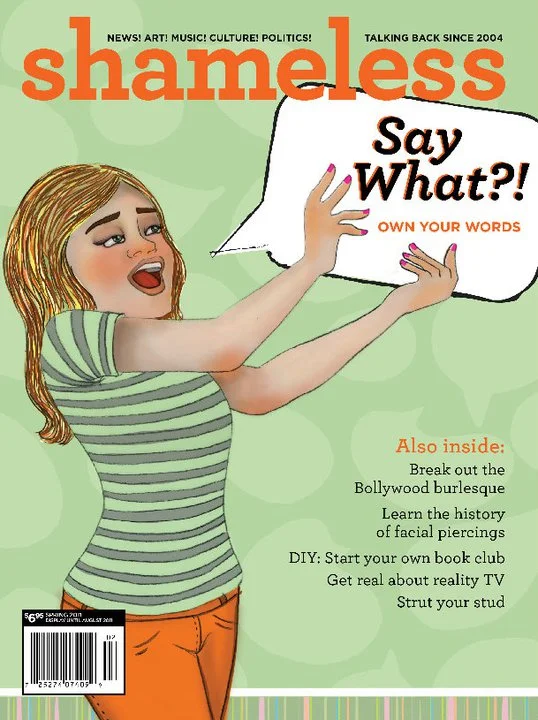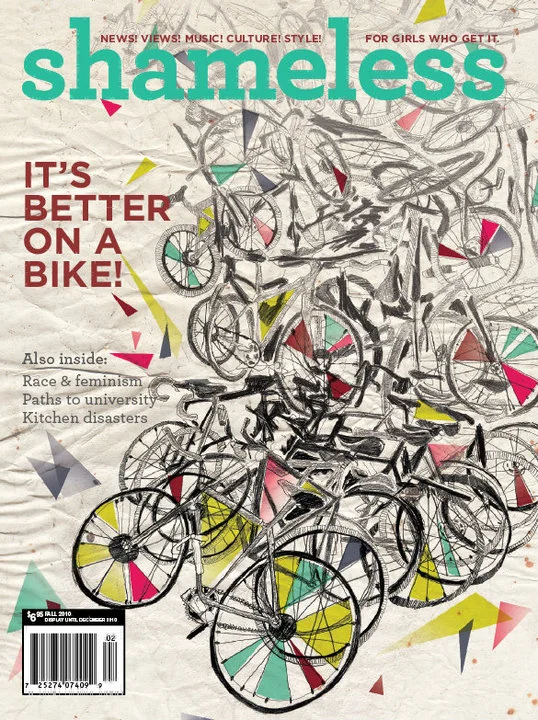(Originally published on shamelessmag.com)
Earlier this week, I was a guest on TVO’s The Agenda. For those of you outside Ontario (or without a television), The Agenda is a nightly current-affairs program, engaging in debates and discussions about politics, culture and society. (Note: video will be online soon; in the meantime, audio can be found here)
I was contacted by a producer of the show, Allison Buchan-Terrell, who invited me to be a guest panelist. As I understood it, the reason for doing this show at this time stemmed from the release of, and backlash against Naomi Wolf’s new book Vagina: A New Biography, and was meant to be a conversation about where the feminist movement is at, and where it is going (i.e. “feminism’s future”).
I had a great conversation with Allison on the phone. I explained that I hadn’t read the book, nor did I intend on reading it (my reasoning for this is below), and when she asked me why, I talked a lot about how I view feminism as being at arm’s length from sex, certainly from biological sex. My feminism is about deconstructing patriarchy, and, to do that, you need to acknowledge that patriarchy rests on broader structures, like colonialism, imperialism and capitalism. I told her that I didn’t see how a book about Wolf’s vagina plays into all of that, and I’d rather continue to focus my organizing around these more fundamental power structures. I was assured that my voice was valuable in that space; the book was only being used to provide broad topics of conversation: biology as destiny, sex and sexuality, privilege and diversity in the feminist movement, and who or what is feminist.
Before I go further, I should say that I believe the Allison had the best of intentions when setting this up. When we spoke, I talked about my own focus on anti-racist, trans-inclusive, queer-positive, class-based, sex-worker-positive feminism rooted in principles of self-determination and historical materialism. I said that without leadership from its most marginalized members, a movement will only ever replicate the broader systems of inequity it’s trying to eradicate. She asked questions and listened. I believe that listening to the experience of others is central to feminist work (again, more on this later).
I was excited to rep my awesome magazine (go Shameless!), to be an intersectional voice, and to talk about what inclusive feminism means to me — not so much in the context of a book that I didn’t read — but in the context of doing community-based work and producing meaningful media. At the same time, I also had my reservations about the show: for one, I’ve held a bit of a grudge against Steve Paikin after his classist comments post-G20, and, more generally, I have a wariness of the culture around liberal #canpoli discourse, which tends to debate politics in very comfortable ways that still support dominant paradigms and violent and racist ideologies (i.e. talk about issues within a broken system without challenging the system itself).
My discomfort around this political space was precisely why I felt like the panel was an important thing to do. Voices like mine are often excluded from the conversation because there is a culture of elitism and a very real lack of safety. I am not a cultural critic nor am I a celebrity feminist. I am a young woman of colour, and a survivor of sexual violence. I work very hard to live and breathe feminist principles in very real ways. I do this work by necessity, as it is a part of my own process of decolonization and survivorship.
My feminism isn’t centered around Naomi Wolf’s vagina
Here’s the thing about Naomi Wolf’s vagina: I just don’t care about it. Wolf was never an important feminist to me. I appreciate that The Beauty Myth was and is a very influential text to a lot of people that I admire and respect, and total props to her for writing it, but understanding beauty as a social construct and as a product of patriarchy (and colonization) was always pretty central to my own survival, and that understanding just happened to come from other places. I was ten years old whenThe Beauty Myth came out; at that time, I read Sassy, idolized TLC and Salt ‘n’ Pepa (after a bitter breakup with NKOTB) and I was learning about the social construction of beauty through my own experiences with pretty severe gendered racism. Years later, I developed most of my politics within the anti-violence movement, and in anti-oppressive spaces by listening to, learning from, and working side-by-side with my sisters at the Toronto Rape Crisis Centre/Multi-Cultural Women Against Rape (an organization all y’all should find ways of supporting). My political career as a feminist managed to largely avoid Wolf (until she made these unfortunate comments last year — what. the. hell.).
So when this book came out, I just didn’t give it much thought. And the more I found myself reading about it (for reviews and excerpts, click here, here, here and here), the more grateful I felt that I’d never put too much faith in this woman in the first place. The excerpts, quotes and descriptions of the book are literally jaw-dropping, and I’d rather save my cash for bell hooks’ new book, and I’d rather save my time to continue the work I’m doing on my own (total shameless plug here).
In other words, it’s just not worth my time: I’ve never wanted to build my feminism by bringing other people down, and I feel strongly that my energy is much better spent focusing on the things I feel areimportant and meaningful. It’s with that spirit that I went into Wednesday’s discussion.
Jong-show
I’d only met Steph Guthrie about half an hour before the live airing, and didn’t see or hear the other panelists until we went live. While I’ve been following Minna Salami’s blog for a while, I’ve not read any of Erica Jong’s twenty-two books. Like Wolf, she was never a part of my feminist trajectory, though I do respect the impact she’s had on a number of people. I was excited to “meet” her.
While I don’t believe in a universal feminism (more on this below), I do believe that as we have these conversations we should be able to rely on a shared set of feminist principles. These principles include acknowledging privilege (and adjusting your own interactions accordingly), respect (in the most basic sense of the word), and an understanding that we have a lot to learn from each other (and so it’s sometimes helpful to sit back and listen). I was disappointed to see that these principles weren’t a part of the feminist politics of some of my co-panelists. In a space where we’re meant to be talking about how the political plays out in one of the most personal of body parts, it only makes sense to think of how our personal interactions with one another are also, in turn, political.
For these reasons, I have a lot to say about how the conversation unfolded. But, more importantly, I feel I need to address some of what was said.
“Naomi is a controversial figure, she wants to be a controversial figure. The other problem is, she’s very pretty, and she has always had men in her life, and women in her life, and she is a sexual object. And, as long as you’re young enough and zaftig enough and pretty enough to be a sexual object, other women hate you. And God help you when you bring out a book. And if you bring out a book that says that you’re multiply orgasmic and that you enjoy sex to the fullest, you are just loathed … the hatred of women against women is on of the major problems in making feminism stick.”
Now, that’s a beauty myth if I’ve ever heard one. I don’t even know where to begin deconstructing this statement. It perpetuates a dangerous and inaccurate stereotype that women, by our very nature, are a bunch of catty b*tches who can’t stand seeing success or happiness in one another. It undermines the concepts of sisterhood, of personhood, decency, love and support upon which community-based feminism is based. And it’s scary because instead of opening up space for the very real criticisms of Wolf’s book, it dismisses, divides and silences. Never mind strong, articulate arguments: haters gonna hate, right? Actually, no.
That being said, I think there is an important conversation to be had around how patriarchy functions in divisive ways, and how this often results in a culture of competition among women and girls. One of the first things I felt I had to do as a self-identified feminist was acknowledge and challenge this tactic in an attempt to overcome it. But without context and analysis, all a statement like that does is say that Wolf isn’t accountable to her feminist community for the things that she says. It’s insulting to critics like Jacklyn Friedman and Laurie Penny (who are hella lovely, by the way), it perpetuates the very beauty myths Wolf herself once wrote about, and it assumes that all of us want to look like able-bodied, femme-identified, zaftig white women. Trust me: we don’t.
On a more fundamental level, sexual objectification has nothing to do with beauty, in the same way that rape doesn’t have anything to do with attraction. Both have every bit to do with power. This reminds me, actually, of an experience I had at an American Apparel store many years ago, when an employee tried to force himself into my change-room while I was trying on a shirt, and then kept trying to grab at me after I came out. When I called and spoke to the manager, she said, “you should be flattered, you must be really pretty — a lot of girls are really into him.” It’s a dangerous attitude to take towards experiences of violence, harassment and objectification — it’s not okay.
“… you have to assume that an intelligent reader will have read Germaine Greer, Betty Friedan, etc., and will see that feminism is a process and that many different thinkers — Adrienne Rich, of Of Woman Born — many different thinkers have applied themselves to these issues.”
I think the only assumption we should be making here is that intelligent readers have diverse feminist trajectories. Many feminists of colour (who are also intelligent readers) have found these works personally irrelevant, because they don’t speak to our unique experiences of colonization and violence, and our unique experiences of sexuality and exoticism. An intelligent reader is not always a straight, white, 2nd-wave cis-woman. In terms of important feminists texts, I strongly recommend the works of people like bell hooks, Angela Davis, Audre Lorde, Himani Bannerji, Vandana Shiva, Rozena Maart, Andrea Smith, Sherene Razack and Dean Spade; the fiction and poetry of Lee Maracle, Dionne Brand and Leah Lakshmi Piepzna-Samarasinha; and the art of Erin Konsmo, Cristy C. Road, Alison Bechdel, and my dear friend Coco Riot.
Looking for a good place to start? Try Jessica Danforth’s Feminism For Real: Deconstructing the academic industrial complex of feminism and, challenge the notion that feminism began during the enlightenment or in a Marxist class war — we have to start looking at feminist history beyond just white history.
“… women are so angry about their own starvation. A woman who can’t have orgasms is not going to like the fact that Naomi Wolf does. A woman who’s vagina is not responding the way Naomi says her vagina is responding is going to be enraged! These are starving people at a feast! Starving women!” (Note: I wish this were a joke)
and, later:
“… [women] don’t get sex. They’re afraid of sex because sex can put you in a terrible miasma of need, and nobody is talking about that — the fact that good sex can make you so needy, so addictive that it almost crowds out everything else in your life. And women don’t want to do that anymore, they fight against it — and I completely understand that — it is difficult when you become so addicted to a lover that you don’t want to do anything else. That is difficult, and the nature the nature of female sexuality when it flowers makes you sometimes behave that way”
These statements (among many other similar statements over the hour) had me floored. We all just need to get laid, right? For any of us who’ve been told we’re “too uptight” and “just need a good f*ck” when we’ve tried to call out sexist, racist and homophobic behaviour, hearing this come from another woman, and — get this — a self-identified feminist, is disgusting. It’s reductionist: it centers women’s needs solely in vaginal sex and, terrifyingly, then suggests that the solution to all our problems lies in the penis. It feeds and fuels rape culture — you know, the same culture that produced a “Beat Up Anita Sarkeesian” video game and later, rape threats directed towards my fellow panelist. This misogyny has been used to fuel sexual violence against queer and gender non-conforming women and trans people, it’s what’s yelled to me from cars when I walk down the street and muttered to me on the subway.
Contrary to some of the statements made during the show, not all women have vaginas, and those who do don’t always like to have sex with men. And women who have sex with men aren’t always interested in penetrative, vaginal sex. And, at the risk of sounding crass, those of us who are interested are stillnot vacuous holes, waiting to be filled. What. the. hell. It’s probably a damn good thing the camera wasn’t on me when these statements were made. Eye rolls for days.
“I think we can all be feminists and we can all push the definition of feminism and make it bigger and bigger and bigger until all women are feminist — that’s my goal … and men, as well.”
While I agree that there are multiple feminisms, and space within the movement for conversations, for the movement to actually achieve anything, we have to build from a set common assumptions and understandings, and we have to be able to do this with some conviction. We need to be able to agree on a trans-inclusive, anti-racist feminism and we need to be very careful not to replicate broader systems of inequity by having the movement lead by its most privileged members. We need to look to our Indigenous sisters, to women and trans people of colour, to queer-identified folks, to women with disabilities, women without (immigration) status, working class women, sex workers and migrant women. We need to look to the people who are hurt the most, not just by patriarchy as we understand it — as a product of the state and of capitalism and of misogynistic culture — but also, by misogynistic feminism, a term I never thought I’d have to use before Wednesday.
As for what is and isn’t feminist: the fact is, that’s a messy and pretty problematic question, and I wish Steve Paikin had listened when I, and other panelists, expressed as much. No, I’m not the feminist police. All I can do is find ways of living the feminism I want to see, and re-adjusting as I ask questions and, yes, listen to the answers. I can only continue to work to find ways of destroying and re-imagining the very systems upon which patriarchy situates — focusing on broader issues like violence, economic and environmental injustice, racism and sexual and reproductive rights — all the issues that we visit, and, more importantly revisit here at Shameless. As a feminist, I can deconstruct these issues through a gendered lens, but it’s an incomplete analysis to just end there. I do believe we should work to a universal feminism, one that is inclusive and intersectional, one that perhaps can start with sex and gender, but should never — ever — end there, and one that doesn’t, and will not ever centre itself in Naomi Wolf’s vagina.
It’s my sincere hope that the next time The Agenda (or any mainstream media) revisits “The Future of Feminism” as a topic for discussion that it is done in a way that allows for the nuances and complexities it requires (and hopefully without the Is this Feminist? quiz-show segment at the end). In the meantime, there’s always Shameless.













